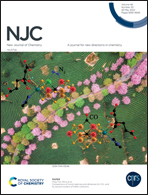Effects of inorganic metal ions on the mixture of single polyoxyethylene chain carboxylate surfactant and Gemini quaternary ammonium surfactant†
Abstract
Anionic and cationic surfactants have high surface activity due to their strong synergistic effect. However, traditional ionic surfactants with excellent application properties easily precipitate in the mixture of anionic and cationic surfactants and do not have salt resistance, which greatly limits their compound application prospect. The introduction of polyoxyethylene group and amide group into anionic and cationic surfactants can not only solve the problem of compatibility, but also make them have good salt resistance. The effects of three metal ions (Na+, Mg2+ and Ca2+) on the mixture of single polyoxyethylene chain carboxylate surfactant (sodium alcohol ether carboxylate surfactant, AE7C-Na) and Gemini quaternary ammonium surfactant (amide diquaternium ammonium chloride surfactant, ADQ-12) are studied. The results show that the mixed system has good tolerance to three ions. The appropriate concentration of metal ions is beneficial to the surface properties and thermodynamic stability of the mixed system, but excessively high concentration is not conducive to the stability of the system, which is related to the radius and valence state of metal ions. The complexation ability of the ethoxy group on the outside of micelle is significantly weaker than that of the amide group on the inside of micelle due to the strong hydrophilicity of the former group. And the complexation ability of mixed surfactants with Mg2+ and Ca2+ is only related to the molar proportion of ADQ-12.



 Please wait while we load your content...
Please wait while we load your content...